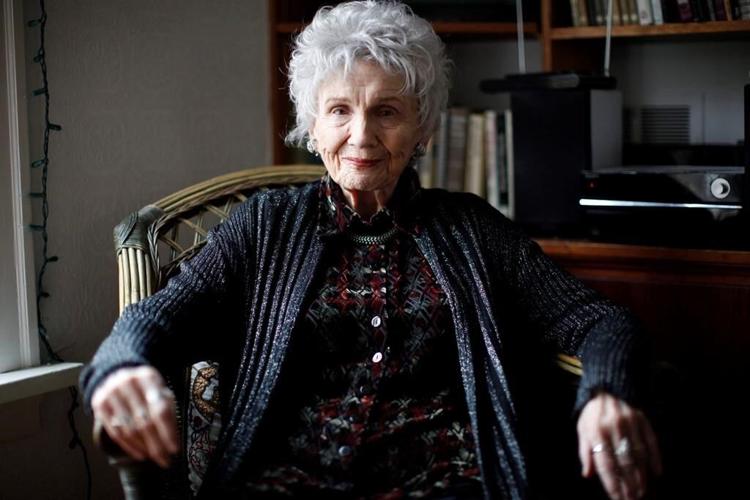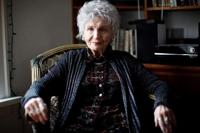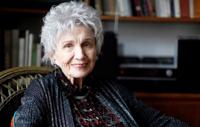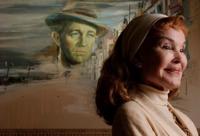Nobel laureate Alice Munro, the şĂÉ«tv literary giant who became one of the world’s most esteemed contemporary authors and one of history's most honored short story writers, has died at age 92.
A spokesperson for publisher Penguin Random House Canada said Munro, died Monday at home in Port Hope, Ontario. Munro had been in frail health for years and often spoke of retirement, a decision that proved final after the author's 2012 collection, "Dear Life."
Often ranked with Anton Chekhov, John Cheever and a handful of other short story writers, Munro achieved stature rare traditionally placed beneath the novel. She was the first lifelong şĂÉ«tv to win the Nobel and the first recipient cited exclusively for short fiction. Echoing the judgment of so many before, the Swedish academy pronounced her a "master of the contemporary short story” who could “accommodate the entire epic complexity of the novel in just a few short pages.”
Munro, little known beyond Canada until her late 30s, also became one of the few short story writers to enjoy ongoing commercial success. Sales in North America alone exceeded 1 million copies and raised "Dear Life" to the high end of The New York Times' bestseller list for paperback fiction. Other popular books included "Too Much Happiness," "The View from Castle Rock" and "The Love of a Good Woman.”
Over a half century of writing, Munro perfected one of the greatest tricks of any art form: illuminating the universal through the particular, creating stories set around Canada that appealed to readers far away. She produced no single definitive work, but dozens of classics that were showcases of wisdom, technique and talent — her inspired plot twists and artful shifts of time and perspective; her subtle, sometimes cutting humor; her summation of lives in broad dimension and fine detail; her insights into people across age or background, her genius for sketching a character, like the adulterous woman introduced as “short, cushiony, dark-eyed, effusive. A stranger to irony.”
Her best known fiction included "The Beggar Maid," a courtship between an insecure young woman and an officious rich boy who becomes her husband; "Corrie," in which a wealthy young woman has an affair with an architect "equipped with a wife and young family"; and "The Moons of Jupiter," about a middle-aged writer who visits her ailing father in a Toronto hospital and shares memories of different parts of their lives.
"I think any life can be interesting," Munro said during a 2013 post-prize interview for the Nobel Foundation. "I think any surroundings can be interesting."
Disliking Munro, as a writer or as a person, seemed almost heretical. The wide and welcoming smile captured in her author photographs was complemented by a down-to-earth manner and eyes of acute alertness, fitting for a woman who seemed to pull stories out of the air the way songwriters discovered melodies. She was admired without apparent envy, placed by the likes of John Updike and Cynthia Ozick at the very top of the pantheon. Munro's daughter, Sheila Munro, wrote a memoir in which she confided that "so unassailable is the truth of her fiction that sometimes I even feel as though I'm living inside an Alice Munro story." Fellow şĂÉ«tv author called her a pioneer for women, and for şĂÉ«tvs.
"Back in the 1950s and 60s, when Munro began, there was a feeling that not only female writers but şĂÉ«tvs were thought to be both trespassing and transgressing," Atwood wrote in a 2013 tribute published in the Guardian after Munro won the Nobel. "The road to the Nobel wasn't an easy one for Munro: the odds that a literary star would emerge from her time and place would once have been zero."
Although not overtly political, Munro witnessed and participated in the cultural revolution of the 1960s and '70s and permitted her characters to do the same. She was a farmer's daughter who married young, then left her husband in the 1970s and took to "wearing miniskirts and prancing around," as she recalled during a 2003 interview with The Associated Press. Many of her stories contrasted the generation of Munro's parents with the more open-ended lives of their children, departing from the years when housewives daydreamed “between the walls that the husband was paying for.”
Moviegoers would become familiar with "The Bear Came Over the Mountain," the improbably seamless tale of a married woman with memory loss who has an affair with a fellow nursing home patient, a story further complicated by her husband's many past infidelities. "The Bear" was adapted by into the 2006 feature film which brought an Academy Award nomination for In 2014, starred in “Hateship, Loveship,” an adaptation of the story “Hateship, Friendship, Courtship, Loveship, Marriage," in which a housekeeper leaves her job and travels to a distant rural town to meet up with a man she believes is in love with her — unaware the romantic letters she has received were concocted by his daughter and a friend.
Even before the Nobel, Munro received honors from around the English-language world, including Britain's and the şĂÉ«tv Book Critics Circle award in the U.S., where the American Academy of Arts and Letters voted her in as an honorary member. In Canada, she was a three-time winner of the Governor's General Award and a two-time winner of the Giller Prize.
Munro was a short story writer by choice, and, apparently, by design. Judith Jones, an editor at Alfred A. Knopf who worked with Updike and Anne Tyler, did not want to publish "Lives of Girls & Women," her only novel, writing in an internal memo that "there's no question the lady can write but it's also clear she is primarily a short story writer."
Munro would acknowledge that she didn't think like a novelist.
"I have all these disconnected realities in my own life, and I see them in other people's lives," she told the AP. “That was one of the problems, why I couldn't write novels. I never saw things hanging together too well.”
Alice Ann Laidlaw was born in Wingham, Ontario, in 1931, and spent much of her childhood there, a time and place she often used in her fiction, including the four autobiographical pieces that concluded “Dear Life.” Her father was a fox farmer, her mother a teacher and the family’s fortunes shifted between middle class and working poor, giving the future author a special sensitivity to money and class. Young Alice was often absorbed in literature, starting with the first time she was read Hans Christian Andersen’s “The Little Mermaid.” She was a compulsive inventor of stories and the “sort of child who reads walking upstairs and props a book in front of her when she does the dishes.”
A top student in high school, she received a scholarship to study at the University of Western Ontario, majoring in journalism as a “cover-up” for her pursuit of literature. She was still an undergraduate when she sold a story about a lonely teacher, “The Dimensions of a Shadow,” to CBC Radio. She was also publishing work in her school’s literary journal.
One fellow student read “Dimensions” and wrote to the then-Laidlaw, telling her the story reminded him of Chekhov. The student, Gerald Fremlin, would become her second husband. Another fellow student, James Munro, was her first husband. They married in 1951, when she was only 20, and had four children, one of whom died soon after birth.
Settling with her family in British Columbia, Alice Munro wrote between trips to school, housework and helping her husband at the bookstore that they co-owned and would turn up in some of her stories. She wrote one book in the laundry room of her house, her typewriter placed near the washer and dryer. Carson McCullers and other writers from the American South inspired her, through their sense of place and their understanding of the strange and absurd.
Isolated from the literary center of Toronto, she did manage to get published in several literary magazines and to attract the attention of an editor at Ryerson Press (later bought out by McGraw Hill). Her debut collection, “Dance of the Happy Shades,” was released in 1968 with a first printing of just under 2,700 copies. A year later it won the Governor’s General Award and made Munro a national celebrity — and curiosity. “Literary Fame Catches City Mother Unprepared,” read one newspaper headline.
“When the book first came they sent me a half dozen copies. I put them in the closet. I didn’t look at them. I didn’t tell my husband they had come, because I couldn’t bear it. I was afraid it was terrible,” Munro told the AP. “And one night, he was away, and I forced myself to sit down and read it all the way through, and I didn’t think it was too bad. And I felt I could acknowledge it and it would be OK.”
By the early ’70s, she had left her husband, later observing that she was not “prepared to be a submissive wife.” Her changing life was best illustrated by her response to the annual şĂÉ«tv census. For years, she had written down her occupation as “housewife.” In 1971, she switched to “writer.”
Over the next 40 years, her reputation and readership only grew, with many of her stories first appearing in The New Yorker. Her prose style was straightforward, her tone matter of fact, but her plots revealed unending disruption and disappointments: broken marriages, violent deaths, madness and dreams unfulfilled, or never even attempted. “şĂÉ«tv Gothic” was one way she described the community of her childhood, a world she returned to when, in middle age, she and her second husband relocated to nearby Clinton.
“Shame and embarrassment are driving forces for Munro’s characters,” Atwood wrote, “just as perfectionism in the writing has been a driving force for her: getting it down, getting it right, but also the impossibility of that.”
She had the kind of curiosity that would have made her an ideal companion on a long train ride, imagining the lives of the other passengers. Munro wrote the story “Friend of My Youth,” in which a man has an affair with his fiancee’s sister and ends up living with both women, after an acquaintance told her about some neighbors who belonged to a religion that forbade card games. The author wanted to know more — about the religion, about the neighbors.
Even as a child, Munro had regarded the world as an adventure and mystery and herself as an observer, walking around Wingham and taking in the homes as if she were a tourist. In “The Peace of Utrecht,” an autobiographical story written in the late 1960s, a woman discovers an old high school notebook and remembers a dance she once attended with an intensity that would envelop her whole existence.
“And now an experience which seemed not at all memorable at the time,” Munro wrote, “had been transformed into something curiously meaningful for me, and complete; it took in more than the girls dancing and the single street, it spread over the whole town, its rudimentary pattern of streets and its bare trees and muddy yards just free of the snow, over the dirt roads where the lights of cars appeared, jolting toward the town, under an immense pale wash of sky.”
___
This story has been updated to correct the title of “The Beggar Maid.”












































